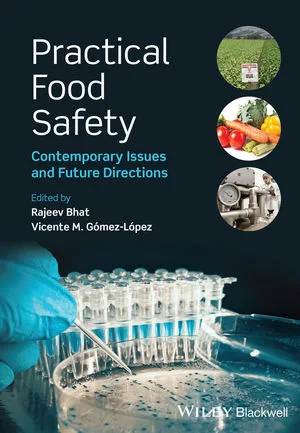Food Safety Issues in New Zealand: An Update
Food is a complex matrix that is prone to the presence of potential hazards, which makes the assurance of food safety a challenging task. Sources of hazards associated with food are numerous, for example, microbial infectious agents, physical contaminants and the presence of potentially toxic chemicals. Generally, it is accepted that the problem of foodborne pathogens pose a greater threat to human health than other kinds of hazards linked to the consumption of food. This scenario puts protection of the public from these infectious agents as a top priority. Foodborne pathogens generally include bacteria, viruses and parasites.
The presence of chemical hazards in foods is another important health risk. Some toxic chemicals in foods are produced naturally by the plants themselves to protect themselves against insects and other herbivores; others are applied intentionally, as additives, or occur as unintentional contaminants, such as pesticide residues. Physical contamination of foods is also a key food safety hazard. A physical contaminant is a physical object that should not be present in food products under normal circumstances. Foreign material (e.g., glass, wood, metal, plastic, rubber, stones and insects) can enter into food during preparation, processing and storage.
It is not a simple matter to assure food safety due to naturally occurring microbial and chemical potential hazards in food as well as the increasing production of processed foods, which have higher risk of physical contamination. However, with appropriate precautions taken during manufacture and distribution, most of the hazards associated with food (e.g., physical hazards) can be prevented or eliminated. For the unpreventable presence of natural foodborne hazards, such as microbes and some chemical hazards, the risk from them can be reduced to a minimum level, which is generally acceptable to consumers.
Major Food Safety Issues in New Zealand
A number of microbial food safety issues have been identified in New Zealand. One of the most important microbial food safety issues is campylobacteriosis, an infection caused by the Campylobacter bacterium. When compared with other industrialized countries, New Zealand has higher incidence rate (i.e., 3-times higher than in Australia and 30-times higher than the United States) of human campylobacteriosis.[1] The situation was worse in May 2006, when the annual national notification rate exceeded 400 per 100,000 for the first time, based on 15,553 cases in the preceding 12 months.[2] This was the highest point of the campylobacteriosis epidemic in New Zealand. Moreover, campylobacteriosis is the most costly foodborne disease recognized within the health system. According to an estimate by the New Zealand Food Safety Authority (NZFSA), the economic cost for campylobacteriosis was $36 million, alone, or 27% of all foodborne disease-specific costs, in 2009.[3] A campaign initiated by the NZFSA to reduce the pathogen Campylobacter in the food chain reduced the rate of foodborne campylobacteriosis in 2007. However, a sharp increase in the numbers of campylobacteriosis cases in some areas was seen recently; for example, the Wellington region had 110 notified cases in August 2011 compared to 66 in August 2010.[4] This reminds us how difficult it can be to manage Campylobacter risk.
Listeriosis, caused by foodborne pathogen Listeria monocytogenes, is another microbial food safety issue frequently dealt with in New Zealand. Food is known to be a major source of L. monocytogenes infections. Expert scientific consultation determined that 90% of the reported listeriosis cases in New Zealand were foodborne.[5] The incidence of reported listeriosis in New Zealand has averaged 0.5 per 100,000 population over recent years, which is similar to that seen in other comparable countries.[6] Although, comparatively, the incidence rate of listeriosis is much lower than campylobacteriosis, listeriosis has a high cost per case. The cost of foodborne listeriosis is the second highest of all foodborne diseases in New Zealand and $15.2 million was spent to treat people and manage listeriosis in 2009.[3] Moreover, listeriosis is a more serious illness with several complications and high risk of premature death. In 2010, seven fatalities were recorded out of 19 cases of foodborne listeriosis in New Zealand.
Chemical hazards originating from food are also a real food safety challenge in New Zealand. Compared with the preventable misuse of chemicals during food processing, natural toxic plant chemicals produced by plants themselves are impossible to eliminate, such as tutin in New Zealand honey. Tutin is a poisonous native plant derivative found in the tutu plant. When vine hopper insects feed on the sap of tutu, the honeydew produced from the insects will contain tutin. If bees gather honeydew THAT contains tutin from tutu bushes, there will be a risk of the toxin being found in the honey.[7] As tutin is highly toxic to humans, the human nervous system can be badly affected by as little as 1 teaspoon (approximately 10 mL) of toxic honey consumed; toxic honey thus poses a serious risk to consumers. Since records began in New Zealand in 1889, there have been many people who died or were incapacitated and hospitalised after eating tutin in honey. Most recently, a tutin honey outbreak occurred in the Coromandel Peninsula in March 2008.[8] A total of 22 people suffered tutin poisoning in this outbreak.
Although the physical hazard incidences are low and affect low number of consumers, physical contamination is still a food safety issue that cannot be ignored. Food safety concerns associated with physical contaminants are numerous, that is, choking, cuts to the month and tongue, broken teeth and damage to the gastrointestinal system.[9] The presence of a physical contaminant in food provides obvious evidence of a hazardous product that is, therefore, likely to be reported and receive complaints. In 2011, nine of 27 food safety recalls related to physical contamination in New Zealand.[10] The physical contaminants that caused those nine food recalls were plastic (four), metal fragments (two), glass and rubber (one each) and a combination of plastic, metal and cloth (one).
Efforts to Minimize Food Safety Risks
The NZFSA has the major responsibility to protect consumers from foodborne hazards and enhance New Zealand’s position as a trusted supplier of food. The NZFSA has taken several steps and applied various approaches to efficiently minimize food safety risks, depending on the nature of the hazard. In order to control microbial hazards in food, the NZFSA established risk management strategies based on scientific research and cooperated with the food industry to reduce the risk of foodborne pathogens. Examples of key measures by the NZFSA to reduce cases of foodborne disease are:
• In September 2007, the NZFSA launched a comprehensive risk management strategy aiming to achieve sustainable reduction in Campylobacter levels in chicken meat through scientifically robust interventions at appropriate points in the food chain, adopting a multi-pronged approach to Campylobacter risk reduction.[11]
• In 2008, a L. monocytogenes risk management strategy was developed by the NZFSA to achieve no increase in foodborne human listeriosis cases from 2008 to 2013.[6] The NZFSA was amalgamated into the Ministry of Agriculture and Forestry (MAF) in 2011. As part of the strategy, in June 2011, the MAF presented “Guidance for the control Listeria monocytogenes in ready-to-eat food,”[12] for minimizing risk of this pathogen to the industry through seminars and workshops.
• Apart from cooperation with the industry to minimise risk of microbial hazards, the MAF recognizes that, due to the natural presence of potential microbial hazards, it will always be important to educate consumers about how to handle foods carefully.
It is impossible to eliminate certain chemical hazards such as naturally produced toxins, for example, tutin in honey. Managing tutin risk to an acceptable level is only one option. Therefore, the NZFSA applied a standard [The Food (Tutin in Honey) Standard 2008] to regulate honey and minimize tutin risk in honey. This standard sets a maximum level for tutin in honey sold for human consumption. The standard also sets up obligations for beekeepers to ensure the safety of their product.
Finally, most of the physical hazards are preventable when all requirements of the food safety regulations are fulfilled. However, it is not easy to create a seamless and integrated regulatory framework for food safety. The NZFSA adopted a risk assessment based food safety programmes and other key legislation, such as the Food Act of 1981 and the Animal Product Act, to prevent, eliminate and minimize microbial, chemical and physical hazards to ensure New Zealand’s food safety.
Conclusions
Food safety hazards put an extra burden on New Zealand’s economy. Microbial hazards affect more people than chemical and physical hazards. Of the microbial hazards associated with foods, campylobacteriosis and listeriosis are the major contributors to the huge health costs in New Zealand. The other two major hazards (chemical and physical) also pose serious threats to human health and cause significant economic loss, that is, 22 people poisoned by tutin in honey (2008) and the nine product recalls from physical contamination (2011) in New Zealand. The MAF is working hard to create a comprehensive legislative and policy framework to minimize the health risks and ensure food safety. Cooperation from the food industry and education of consumers are vital to minimize the food safety risks in New Zealand.
Zilun Shi is a postgraduate student and Malik Hussain, Ph.D., is a lecturer in food microbiology in the department of wine, food and molecular biosciences at Lincoln University, New Zealand. Dr. Hussain can be reached at malik.hussain@lincoln.ac.nz.
References
1. Baker, M., E. Sneyd and N. Wilson. 2006. Is the major increase in notified campylobacteriosis in New Zealand real? Epidemiol Infect 6: 1–8.
2. Baker, M., N. Wilson, R. Ikram, S. Chambers, P. Shoemack and G. Cook. 2006. Regulation of chicken contamination urgently needed to control New Zealand’s serious campylobacteriosis epidemic. N Z Med J 119: 1243.
3. www.foodsafety.govt.nz/elibrary/industry/economic-cost-foodborne-disease/foodborne-disease.pdf.
4. www.foodsafety.govt.nz/elibrary/industry/2012-january-Food-Connect.pdf.
5. Cressey, P. and R. Lake. 2005. Ranking Food Safety Risks: Development of NZFSA Policy 2004-2005. ESR: Christchurch Science Centre.
6. www.foodsafety.govt.nz/elibrary/industry/Listeria_Risk-Aims_Help.pdf.
7. en.wikipedia.org/wiki/Tutin_(toxin).
8. www.foodsafety.govt.nz/elibrary/industry/Consultation_Produces-weather_Pundits.htm.
9. CSIRO Food and Nutritional Sciences. 2010. Make it safe–A guide to food safety, pp. 4 and 5. CSIRO Publishing: Collingwood, Australia.
10. www.foodsmart.govt.nz/food-safety/recalls/latest-recalls/.
11. www.foodsmart.govt.nz/elibrary/campylobacter-poultry-risk-2007-2010/updated-campystrat07-08.pdf.
12. Barnao, C. 2011. Help to limit Listeria proves a drawcard. N Z Food Technol 46: 22.
Looking for quick answers on food safety topics?
Try Ask FSM, our new smart AI search tool.
Ask FSM →







